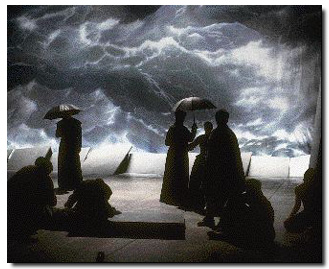Main Menu · Search · Current Issue · Contact · Archives · Centennial · Letters to the Editor · FAQs
 The American Repertory Theatre's dramatic style on display in Hamlet, 1991. Photograph by Richard M. Feldman |
![]()
A committee of administrators and faculty members will review the relationship of the American Repertory Theatre (ART) to the University and to the Faculty of Arts and Sciences, FAS dean Jeremy Knowles reported to the Faculty Council in December.
Former vice president and University general counsel Daniel Steiner, who chairs the committee, says it will look at the relationship between the ART and undergraduate drama (including use of the Loeb mainstage), at the ART's finances, and at its governance mechanisms. The committee will meet with students as part of the review process. No date has yet been set for completion of its work.
Robert Brustein, who is artistic director of the ART, director of the Loeb Drama Center, and professor of English, notes that prior reviews of this kind have brought positive attention to the company, which is an independent nonprofit corporation affiliated with FAS. Since the 1979-80 academic year, the ART's home venue has been the Loeb mainstage, which is at present reserved for undergraduate use 12 weeks a year. Part of the ART's mandate, says Brustein, is "to provide oversight and advice, usually technical, to undergraduate productions." In addition, the ART teaches and funds roughly a dozen undergraduate courses in drama each year.
According to Robert Orchard, managing director of both the Loeb and the ART, 60 to 65 percent of the company's $7 million in annual income derives from ticket sales. A continuing University subsidy for the activities of the Loeb provides just under 10 percent of the ART's annual income, and predates the company's arrival at Harvard. (Last year's subsidy was $687,500). Another two to three percent of the ART's income for operations comes from its own endowment. Of the remaining grant and donation income, less and less comes each year from federal and state sources, because overall government appropriations in this area have declined. The National Endowment for the Arts (NEA), for example, continues to rate the ART the top resident theater company in the country and to reward it commensurately. Yet "NEA grants have declined from $800,000 more than 10 years ago to $100,000 this year," says Orchard. Individual contributions, he notes on the other hand, "over the last few years have increased about 15 percent a year."
Main Menu ·
Search · Current Issue · Contact · Archives · Centennial · Letters to the Editor · FAQs
![]()